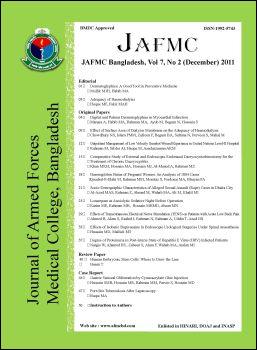Human Embryonic Stem Cells Where To Draw The Line
DOI:
https://doi.org/10.3329/jafmc.v7i2.10396Keywords:
Embryo, stem cell, research ethicsAbstract
Introduction: Human-embryonic stem cells (hESC) are derived from very early stages of the human embryo. These cells have immense plasticity and can be conditioned to develop into any type of cell of the human body. Despite all their promising utility, hESC researches have recently been the subject of fervent debate.
Objective: This paper explores the implications of hESC therapy from a bio-ethical perspective.
Method: Published literature with strict inclusion and exclusion criteria was extensively reviewed through use of general and meta search engines to elucidate the applications and implications of hESC.
Discussion: Studies indicate that the potential of hESC in reconstructive and regenerative medicine is undisputable but complex social and moral issues are hopelessly intertwined beneath the pleasant facade. hESC offer endless possibilities in understanding bio-molecular disease patterns, supplying readymade healthy organs, interpreting aging and organogenesis at the cellular level. The use of hESC is well established in leukemia and scientists anticipate diverse applications in a wide range of congenital and acquired medical conditions. However, many dilemmas arise in context of their biomedical usage because of the destruction of donor human embryos in producing stem cells, adverse transplant reactions, teratogenecity, phenotypic / genotypic abnormalities, nonstandardized research laws, logistic issues and the possibility of eternal life and humanoid chimeras.
Conclusion: The wisdom to choose between ' mindful utilization' and 'senseless exploitation' lies with us. The large scale commercialization of human life or the killing of viable embryos cannot be justified by any means. A neutral approach with increased involvement of uncontroversial progenitors should be adopted.
DOI: http://dx.doi.org/10.3329/jafmc.v7i2.10396
JAFMC 2011; 7(2): 40-43
Downloads
182
206

